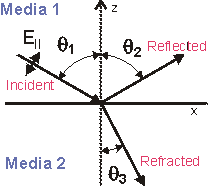Let us consider the beam of light incident on the boundary surface between two substances - glass with refractive index n=1.5 and air with refractive index n=1. One part of light will reflect from such a boundary surface and other part will pass through it being refracted. The total energy in the reflected and refracted rays is equal to the energy of the incident light, but the proportion of the intensities in these two rays will depend upon the refractive index difference, the angle of incidence, the light polarization and direction in which the light is passing the border (from glass to air or from air to glass). Animations below show four possible cases of the light beam transmission:
|
Glass -> Air |
Video | Air -> Glass | Video | |
| Parallel polarization |
 |
 |
||
| Perpendicular polarization |
 |
 |
||
The polarization is called parallel when the vector of electric field E lies in the plane of incident ray and normal to the border (see the figure below). In other case the polarization is called perpendicular
 According to Fresnel formula the angles q1of the incident wave,
q2 of the reflected
wave and q3 of the
refracted wave are given by the equation:
According to Fresnel formula the angles q1of the incident wave,
q2 of the reflected
wave and q3 of the
refracted wave are given by the equation:
q
1 = q2n1sin
q1 = n2sinq3The intensity reflection coefficients R
|| and R^ and transmission coefficients T|| and T^ (for the parallel and perpendicular polarization consequently) are described by the equations:
For the ray incident normally to the border there is no difference between the parallel and perpendicular components. In this case we can write:

The dependencies for the reflection coefficients R and for transmission coefficients T are given in the following figures:
 We can see from these figures and animations that
for the light incident from the glass into the air there is an angle when the
Total Internal Reflection (TIR) is observed. This means that any ray propagating
in a glass at angles bigger than a critical angle (about 42° for glass-air interface) will be totally
reflected and will not pass into the air. This effect is used for transmission
of the light signals by the glass fiber over the large distance without a
considerable attenuation.
We can see from these figures and animations that
for the light incident from the glass into the air there is an angle when the
Total Internal Reflection (TIR) is observed. This means that any ray propagating
in a glass at angles bigger than a critical angle (about 42° for glass-air interface) will be totally
reflected and will not pass into the air. This effect is used for transmission
of the light signals by the glass fiber over the large distance without a
considerable attenuation.
qTIR = arcsin(n2/n1), n1 > n2
 We can see also in the figure that for the
light propagating from the air into the glass there is an angle at which the
light with parallel polarization will not reflect, while the intensity of the
perpendicularly polarized light is not zero. This angle is called Brewster's
angle (56°40' for glass-air
interface) and used for creation of the light polarizers and in
lasers.
We can see also in the figure that for the
light propagating from the air into the glass there is an angle at which the
light with parallel polarization will not reflect, while the intensity of the
perpendicularly polarized light is not zero. This angle is called Brewster's
angle (56°40' for glass-air
interface) and used for creation of the light polarizers and in
lasers.
qBR = arctg(n2/n1), n1 < n2